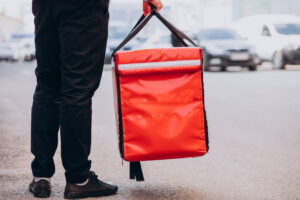Staying environmentally friendly whilst packaging chilled food, such as recipe boxes or home food deliveries, is very important. It’s vital to keep the food fresh and damage-free to minimise waste and customer satisfaction.
There are several ways you can package chilled food, whilst maintaining your eco ethics.

Choosing sustainable plastics:
Switching to sustainable plastics is a great way to immediately improve your eco credentials.
You could choose single-use compostable, plant-based plastics. This will mean that the plastic degrades away and leaves no trace after 12 weeks.
Or you could choose to reuse, by opting for high quality, heavy duty plastics that can be reused hundreds of times, and then recycled at the end of their functional lives.
Reduce the size of your packaging:
Oversized, aesthetically pleasing packaging has been commonplace for years. With the global shift in awareness of the environmental impact of surplus packaging, consumers are caring less and less about aesthetic presentation, and more and more about the reduction of packaging.
Vacuum food sealing is a great way to reduce the amount of packaging, and keep the food fresher for longer because it does not oxidise.
Functional designs, with clear labelling and no excess materials, are now favoured by most consumers.
Efficient Insulation:
To keep products cool, they must be insulated.
This can be done by delivering the products in an insulated truck, which is a common delivery method by supermarkets.
Or this can be achieved using insulation packs. These insulation packs can either be high-quality made-to-last packs that the customer may reuse or return to you, or these can be packs made of easy to recycle materials.
Optimise your space:
Optimising your space is vital to reduce the number of food miles and carbon footprint created by your deliveries. An improved energy efficiency from choosing the correct size packaging means that more products can be delivered on the same trip. To do this, you can take your minimum box measurements and insert them into our box calculator.
Ensuring the amount of parcels per trip is maximised, also has the added benefit of offering extra insulation to the products being delivered, as they will naturally insulate each other.
Encourage return or reuse of packaging:
As touched on above, one of the most sustainable ways to pack is returnable or reusable packaging.
If you choose a high quality and long-lasting product for example wooden boxes, it can be used for hundreds of trips, instead of one trip, as is the case for single-use plastics. It may also be kept by the customer and reused by them.
An added bonus of your customer reusing your packaging, for example ice packs for food transport, if they are branded, your customer will constantly be reminded of your business.
Alternatively, you can offer incentives for customers returning your packaging. A great example of this is Boston Tea Party. They no longer offer disposable cups, and instead have a “Loan” scheme. This scheme involves the customer paying a refundable deposit for the cup, and returning the cup to any Boston Tea Party for a refund.
To learn more about this scheme, please click here to be taken to the Boston Tea Party website.
Provide customers with clear storage instructions:
To avoid spoiling, it is a good idea to clearly label storage instructions for your produce. This will help avoid accidental incorrect storage, and in turn, food waste.
Explore new packaging solutions:
The packaging industry is a fast moving place, with new innovations all the time. Keeping up to date with the latest packaging solutions will help you streamline the packaging process, and contribute towards a sustainable future.
Educate the end user:
Raise awareness among your customers about why you are making changes, how important these changes are and how they can get involved. Including calls to action such as “Compost me” or statistics on how the desired action can contribute towards a circular economy.







